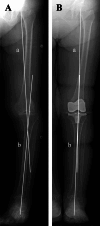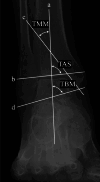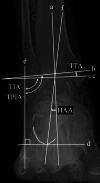Does the coronal plane alignment of the ankle and subtalar joints normalize after total knee arthroplasty?
- PMID: 40340766
- PMCID: PMC12063276
- DOI: 10.1186/s43019-025-00272-7
Does the coronal plane alignment of the ankle and subtalar joints normalize after total knee arthroplasty?
Abstract
Background: Total knee arthroplasty (TKA) alters the lower extremity alignment, potentially affecting adjacent joints such as the ankle and subtalar joints. However, the relationship between changes in hindfoot alignment and ankle osteoarthritis (OA) after TKA remains incompletely understood. The purpose of this study was to clarify whether ankle and subtalar alignment normalizes after TKA and to identify factors associated with persistent malalignment.
Methods: We retrospectively analyzed 331 patients who underwent unilateral mechanical alignment (MA) TKA for knee osteoarthritis. A control group of 40 healthy subjects was used to define normal alignment ranges. Whole-leg anteroposterior weight-bearing radiographs were obtained preoperatively and 2 months postoperatively. Alignment parameters included the hip-knee-ankle angle (HKA), tibiotalar tilt angle (TTA), tibial plafond inclination angle (TPIA), talar inclination angle (TIA), and hindfoot alignment angle (HAA). Pre- and postoperative values were compared using the Wilcoxon signed-rank test, and changes in the proportion of patients within the normal range were determined. Wilcoxon rank-sum tests and chi-squared tests were used for group comparisons, and multivariate logistic regression identified independent predictors of persistent malalignment.
Results: HKA improved after TKA (-12° to -2.0°), with corresponding improvements in TPIA (99° to 94°) and TIA (99° to 95°) (all p < 0.001), indicating a significant correction toward neutral alignment. The proportion of patients within normal range increased postoperatively from 16% to 85% for HKA, 26% to 67% for TPIA, 24% to 64% for TIA, and 65% to 73% for HAA. Multivariate analysis identified ankle OA (odds ratio [OR] = 6.62 for TTA), female sex (OR = 2.32 for TPIA; OR = 3.19 for TIA), and varus knee alignment (OR = 2.81 for TIA) as independent predictors of persistent malalignment.
Conclusions: MA-TKA facilitates partial normalization of coronal hindfoot alignment, particularly at the tibial plafond and talus. However, female sex, varus knee deformity, and pre-existing ankle OA independently limit full correction. These findings highlight the biomechanical interdependence between the knee and hindfoot and may guide surgical decision-making and patient-specific alignment strategies.
Keywords: Ankle osteoarthritis; Coronal alignment; Hindfoot alignment; Subtalar joint; Total knee arthroplasty.
© 2025. The Author(s).
Conflict of interest statement
Declarations. Ethics approval and consent to participate: Each author certifies that his/her institution approved the human subject protocol for this investigation and that all investigations were conducted in conformity with the 1964 Helsinki Declaration. Ethical approval for this study was obtained from the institutional ethical review board of the Faculty of Medicine, Saga University (no. 2022-06-R-05), and the requirement for informed consent of the participants was waived by the institutional ethical review board of the Faculty of Medicine, Saga University, owing to the retrospective nature of the study. Consent for publication: Ethical approval for this study was obtained from the Faculty of Medicine, Saga University (no. 2022-06-R05). Competing interests: The authors declare no competing interests.
Figures





Similar articles
-
Compensatory changes in lower limb alignment following total knee arthroplasty: large valgus knee correction (≥ 10°) demonstrates substantial alterations in ankle and subtalar joint alignment.Arch Orthop Trauma Surg. 2025 May 30;145(1):322. doi: 10.1007/s00402-025-05935-4. Arch Orthop Trauma Surg. 2025. PMID: 40445330
-
Weight-bearing line at the ankle joint level shifted laterally after total knee arthroplasty for varus knee osteoarthritis: Evaluation of the hip-to-calcaneus line.Orthop Traumatol Surg Res. 2024 Apr;110(2):103690. doi: 10.1016/j.otsr.2023.103690. Epub 2023 Sep 21. Orthop Traumatol Surg Res. 2024. PMID: 37741441
-
Ankle alignment before and after total knee arthroplasty in patients with valgus knee deformity.J Orthop Surg Res. 2025 Apr 18;20(1):389. doi: 10.1186/s13018-025-05800-5. J Orthop Surg Res. 2025. PMID: 40247287 Free PMC article.
-
Highly variable coronal tibial and femoral alignment in osteoarthritic knees: a systematic review.Knee Surg Sports Traumatol Arthrosc. 2019 May;27(5):1368-1377. doi: 10.1007/s00167-019-05506-2. Epub 2019 Apr 15. Knee Surg Sports Traumatol Arthrosc. 2019. PMID: 30989273
-
Alignment of the hindfoot in total knee arthroplasty: a systematic review of clinical and radiological outcomes.Bone Joint J. 2021 Jan;103-B(1):87-97. doi: 10.1302/0301-620X.103B1.BJJ-2020-0143.R1. Bone Joint J. 2021. PMID: 33380206
References
-
- Kurtz S, Ong K, Lau E, Mowat F, Halpern M (2007) Projections of primary and revision hip and knee arthroplasty in the United States from 2005 to 2030. J Bone Joint Surg Am 89:780–785 - PubMed
-
- Okamoto Y, Otsuki S, Jotoku T, Nakajima M, Neo M (2017) Clinical usefulness of hindfoot assessment for total knee arthroplasty: persistent post-operative hindfoot pain and alignment in pre-existing severe knee deformity. Knee Surg Sports Traumatol Arthrosc 25:2632–2639 - PubMed
-
- Cho W-S, Cho H-S, Byun S-E (2017) Changes in hindfoot alignment after total knee arthroplasty in knee osteoarthritic patients with varus deformity. Knee Surg Sports Traumatol Arthrosc 25:3596–3604 - PubMed
-
- Lee JH, Jeong BO (2012) Radiologic changes of ankle joint after total knee arthroplasty. Foot Ankle Int 33:1087–1092 - PubMed
-
- Kim C-W, Gwak H-C, Kim J-H, Lee C-R, Kim J-G, Oh M et al (2018) Radiologic factors affecting ankle pain before and after total knee arthroplasty for the varus osteoarthritic knee. J Foot Ankle Surg 57:865–869 - PubMed
LinkOut - more resources
Full Text Sources

